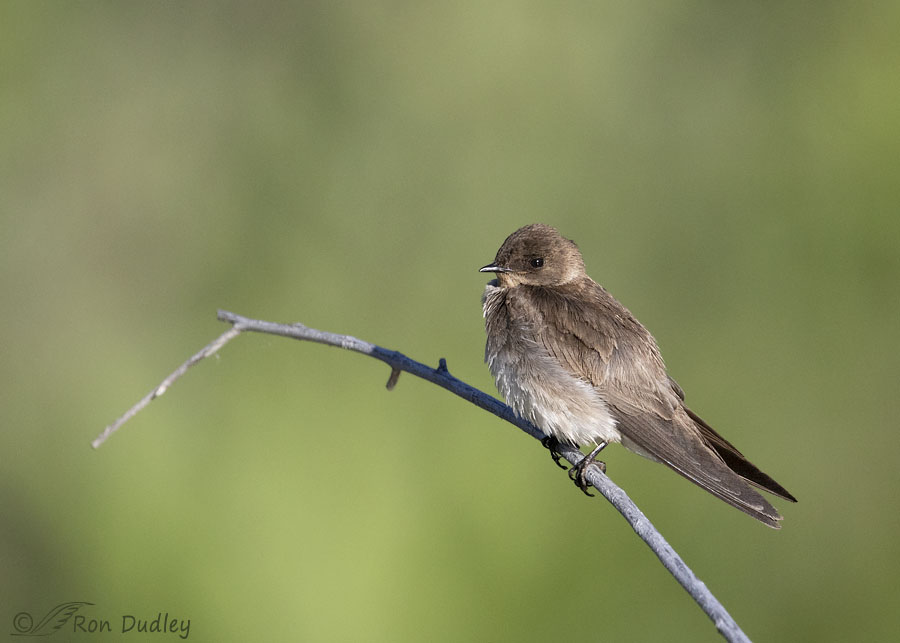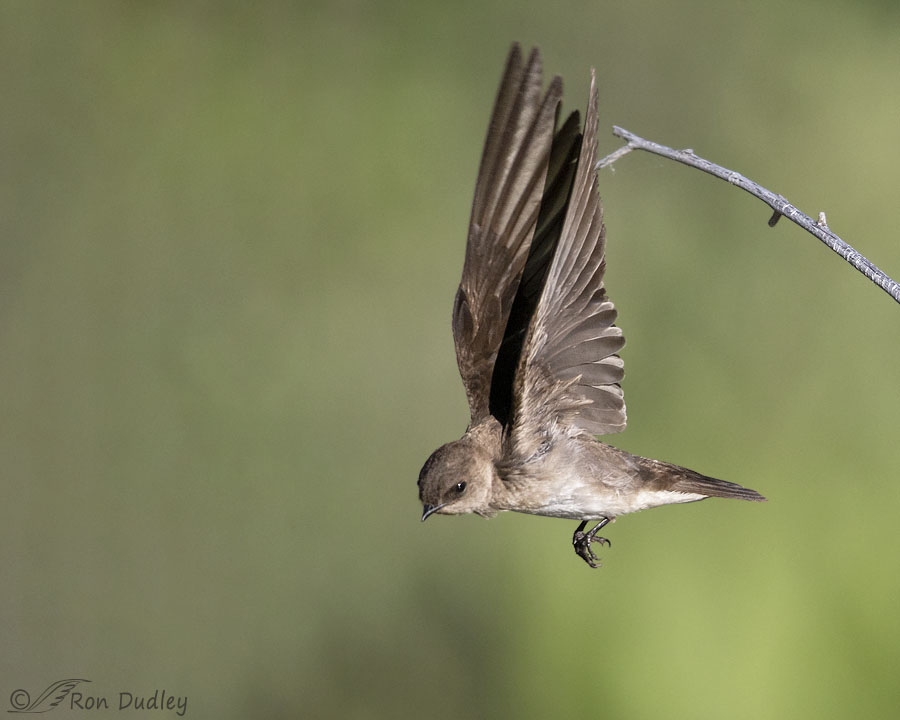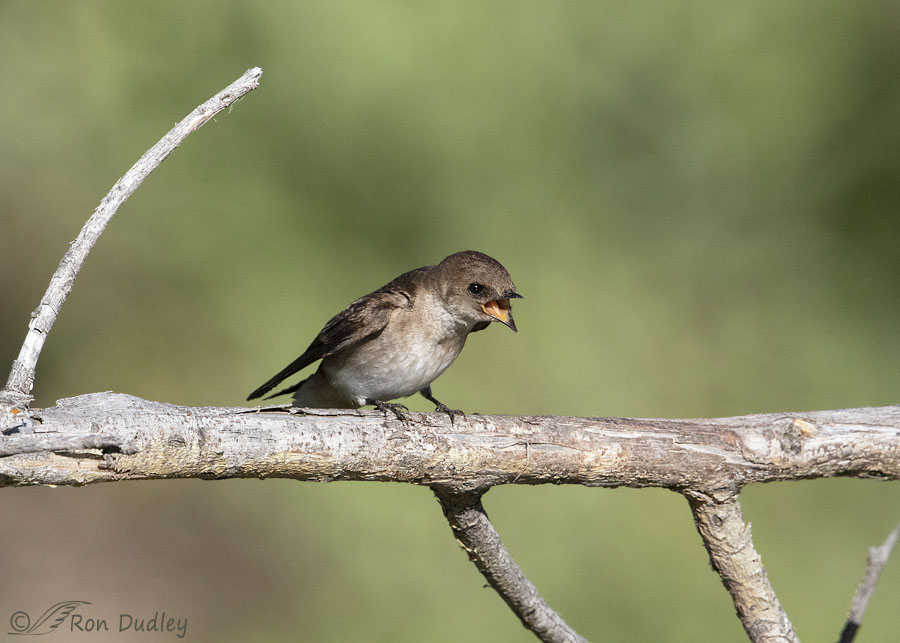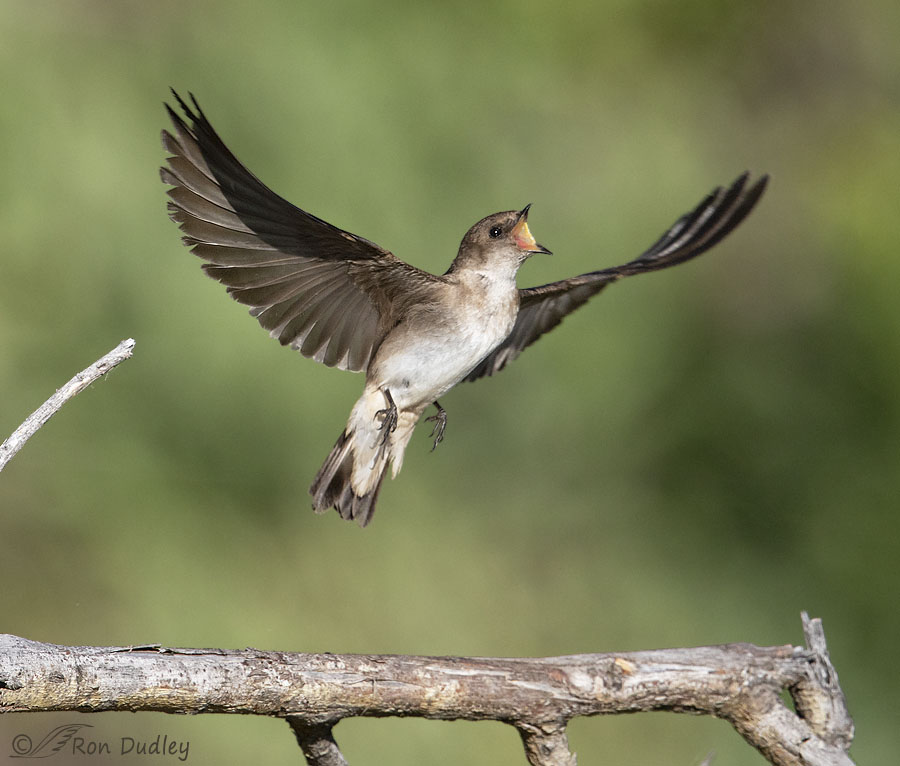Northern Rough-winged Swallows are fairly common throughout their breeding range but they’re easily missed by birders, in part because they’re largely solitary rather than colonial. Of all North American swallows far fewer of of this species are noticed and counted during bird counts and I seldom see them myself. But for the last couple of mornings a single Rough-winged Swallow has been hanging around a mountain stream I frequent, along with quite a few Barn Swallows.
Thanks to the Barn Swallows this poor little guy had a rough morning yesterday.

1/4000, f/5.6, ISO 800, Canon 7D Mark II, Canon EF 500mm f/4L IS II USM + EF 1.4 III Extender, not baited, set up or called in
His morning started out pretty well. He lazed on this perch overhanging the stream for quite a while, preening and seeming to do a lot of relaxing and warming up in the sun soon after sunrise. It was an unusually cold morning in the 30’s so few of the other swallows had yet begun to hunt insects on the wing over the slow flowing stream so they mostly left ‘him’ in peace.
At first there were few subjects near the stream for me to photograph so it became my intention to catch him in flight if he ever took off. But he was content where he was so it was a long wait.

1/4000, f/5.6, ISO 800, Canon 7D Mark II, Canon EF 500mm f/4L IS II USM + EF 1.4 III Extender, canvas added for composition, not baited, set up or called in
But I was paying attention when he finally launched so I was lucky enough to get this shot of him in flight with light in his eye and a wing position that I like. For this version of the photo I had to add canvas to get an acceptable composition.
But in the 28 minutes between this shot and the next two his situation became much more intense. It was warming up quickly so insects began to fly over the stream and Barn Swallows began to pursue them.
In the process they mercilessly harassed and even attacked the Rough-winged Swallow no matter where he perched.

1/5000, f/7.1, ISO 800, Canon 7D Mark II, Canon EF 500mm f/4L IS II USM + EF 1.4 III Extender, not baited, set up or called in
By now our hero had moved to a different perch that some readers may recognize as the same one used by a male Belted Kingfisher in a photo I posted several days ago. While Barn Swallows were snagging insects over the water they would take every opportunity to harass the rough-winged whenever they came close.
This was the beginning of his reaction to one of the incoming Barn Swallow attacks.

1/4000, f/7.1, ISO 800, Canon 7D Mark II, Canon EF 500mm f/4L IS II USM + EF 1.4 III Extender, not baited, set up or called in
But this time instead of simply taking the aggression while perched he responded aggressively himself by launching toward his incoming attacker and I was able to get this shot that I like very much. His aggressive posture in flight is something I’ve never been able to capture in a swallow in the past and I love the background. I had no idea I’d captured anything like this shot until I got home and looked at my images on my computer.
Which is one reason I never chimp (delete) images in the field. Culling can always wait.
Ron
Note: If you’re curious about how Rough-winged Swallows got such an unusual name here’s the real poop from Cornell’s Birds of the World:
- “This swallow’s most distinguishing characteristic is its “rough” primary feather, from which its common name has been derived. In adults the stiffened barbs of the leading web of the outer primary feather lack terminal barbules. In males the barbs are recurved into minute hooklets, and in the female they are prolonged into a definite, naked point that is little or not at all recurved. In males this produces “a file-like roughness when the finger is drawn along the edge of the quill from base toward tip”. Early taxonomists were so taken with this characteristic that they referred to it in both the genus and species portions of this bird’s scientific name. The Greek appellation for the genus, Stelgidopteryx, is a combination of two words meaning “scraper wing,” and the species name of serripennis, assigned by Audubon, is a combination of two Latin words meaning “saw feather.” The possible adaptive significance of this feature remains a mystery.”


Wonderful photos (agreed about the background) and great story. I’m a sucker for inspiring underdog triumphs, as apparently are your other commenters. Remarkable that this Swallow is so widespread- all over the U.S.-yet uncommon.
Lyle, I’ve only noticed them a few times over the years but I’ll bet I’ve SEEN them many more times than that.
Those small birds do not usually give signals when they are ready to fly as raptors often do. Your patience was rewarded. Although birds cannot change their facial expressions, the body language of this fellow communicates its feelings towards his harassers.
That’s right, Kenneth – this guy was less than pleased at being constantly harassed.
I love that when he reached breaking point you and your camera were ready.
Yet another amazing series.
And yes, Laura is right. There is undoubtely a reason for that ‘rough wing’, but this reclusive species has kept it well hidden.
I’d love a chance to actually feel that “rough wing” in my hand, EC. Maybe one day…
Thank you for the introduction to this feisty gentleman. I found myself cheering him on as I looked at the last two shots. That last shot is something else! Hope he got a little peace and a chance to get some breakfast.
I was actually cheering him on in the field, Marty. Quietly of course…
Wonderful photos. It is interesting that this species is common throughout all of North America and Mexico, yet, it is mostly ignored by most people to the extent that it is largely unknown to most non-birders. Where they co-exist many people confuse them with Bank Swallows and they often nest in burrows at the margins of Bank Swallow colonies. But the two are quite different in social behavior. Bank Swallows are so social that egg-laying and hatching often come into synchrony within the entire colony. Northern Rough-winged Swallows nest together because of limited habitat availability, but they remain very independent from each other. By the way. there is another species, the Southern Rough-winged Swallow, that is found throughout much of South America.
Thanks for providing that very interesting background, Dan.
Gorgeous catch! I did not know that about the feather structure, very interesting. If I get the chance to check out a feather I will!
I hope you’ll report back to us if you get that chance, April.
What a little cutie. I really like the progression from sitting quietly to active flight to a cry of warning to “get out of my face.” Happy Saturday!
Thank you, Cathy.
So fun to see these, Ron! You are a patient man with a wonderful eye…and that ain’t all!
Thanks, Mary. With these types of shots there typically isn’t much choice – you either have to be patient or you get skunked.
WOW! Now there’s an education this morning. I’ve never even heard of this species, let alone seen one! As for the evolution of the primaries, I can’t even begin to make a guess of the why part of that, but I’m CERTAIN there’s a good why. It’s just not evident to our clunky human minds 😉
I really hate it that the barn swallows were harassing him. Poor little guy! I hope he managed to get enough to eat amid the chaotic melee. He might/probably has a nest full of little ones that he needs to help feed, too!
And what SPLENDID images!! Not to be ridiculously redundant again, BUT…you just ROCK!!
Thanks very much, Laura. You’re not alone in being unfamiliar with this species.
Fantastic catch! Love, love, love that final photo. He showed his moxie…good for him! I’m curious, as Dick is , to the outcome.
Kathy, as far as I could tell he wasn’t even hungry. Never did see him try to catch any insects.
Feisty little bird! Really wonderful, unusual shot.
Thanks, Nancy.
Wow Ron, that attacking photo is sensational. Getting a take off shot of any swallow is remarkable, but to get a shot like this is awesome. When I first started taking bird photos here years ago I would see swallows flying all over and never thought they ever took a break. One day I came around a bend at our North Willow Lake and I could not believe what I was seeing. There were approximately 75 Northern Rough-winged Swallows all perched together on two low snag trees and they just all stayed there posing for me while I took probably 100 or more shots.
That many off this species in the same place is highly unusual, Everett. Hope you got some shots that included most or all of them.
Wonderful series, Ron….. 🙂 Taking off to meet his attacker is REALLY great. It’s actually a bird I believe I’ve seen/heard around here…. 😉 Definitely would be inconspicuous except on the power line across the creek…….
Yup, inconspicuous describes them well, Judy. Thanks.
These are some great shots of a little understood swallow! Many thanks for capturing these images and sharing them with us.
So, was the this fellow ever successful or did the Barn Swallows prevent him from catching a meal?
I never even saw him try to feed, Dick. He was just attempting to be laid back.